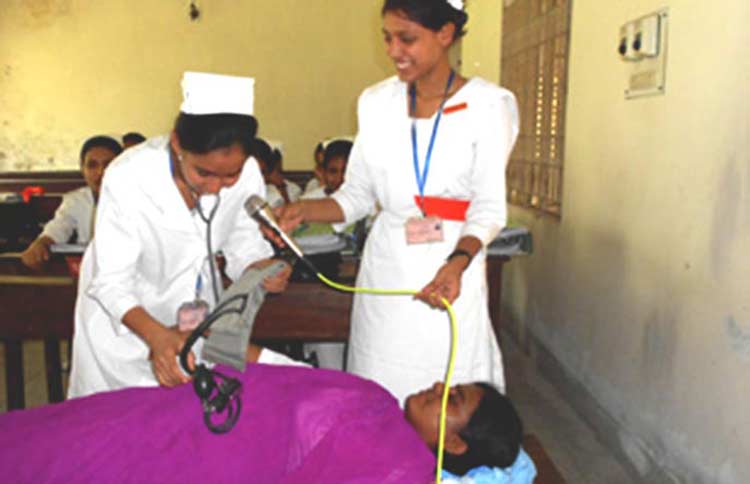
UBINIG
WHO has compiled the vital statistics for maternal and perinatal health for South East Asia region. For Bangladesh the annual number of births is 3.5 million and annual number of maternal deaths is 5,200 as of 2013. The maternal mortality ratio is 170 per 100,000 live births. About 71% of babies are delivered at home, 11.8% in public hospitals and 15.1% in private hospitals . In terms of services providers only 21% are qualified doctors, 6.1% are nurse, midwife and auxillary nurse, and the majority 72.4% are at the hands of traditional birth attendants or by family members. That means the home deliveries (71%) are usually assisted by the traditional birth attendants (72.4%). The maternal health workforce needed for maternal healthcare is insufficient. There are only 33,061 nurse, midwife and auxillary nurses, 802 obstreticians and gyneacologists and the rest qualified doctors are general physicians 53,603 who have to attend other healthcare services. The other human resources for maternal healthcare include medical as¬sistants, pharmacists, medical technologists, family welfare visitors, community-based skilled birth at¬tendants, family welfare assistants, and health assis¬tants. All these workforces can not deal with the real causes of maternal deatyhs, but they can help in monitoring of the health conditions of the pregnant women and provide some medicines. The health facilities include District Hospitals under Health Services Wing (59), Maternal and Child Welfare Centres under Family Planning Wing (97), Union Health and Family Welfare Centres under Family Planning Wing (3478). The other higher level facilitiese only available in the Medical Colleges and the Capital City Dhaka.
The maternal healthcare includes Antenatal Care (ANC), Basic Essential Obstretric Care (BEOC), Comprehensive Essential Obstretric Care (CEOC), Maternal and Child Health Care (MCHC) and Post Natal Care (PNC). The Antenatal Care is provided in almost all UHFWC, MCWC, UHC and district hospitals. The Basic Essential Obstretric Care (BEOC) is available in only few UHFWC, in MCWCs and in most UHCs. Comprehensive Essential Obstretric Care (CEOC) is not available in UHFWCs. But it is available in 62 MCWCs, 77 UHCs and in the district hospitals. That means pregnant women who needs CEOC have to go mostly to the district hospitals for the comprehensive obstretric care. The field based health and family planning workers have training on BEOC (6 months) and at the hospitals nurses have midwifery training of 1 year and Medical Assistans or the Sub-Assistant Community Medical Officers (SACMO) provide BEOC services at the Union level health facilities. An UNFPA initiative resulted in 600 certified midwives, nurse-midwives who completed a six-month post-basic training, have already been posted to sub-district level health facilities in late 2015.

Reality of institutional child deliveries
Based on the real facts about the facilities and the human resources it is not possible for all women who give birth to go to a facility for the services. Even if they want to go there are many other factors that determine the accessibility to the services such as distance to the facility, availability of the transportations and other social and economic factors. It is also not the government’s intention to have all the child deliveries to be institutional. It is neither possible nor recommended. The concern is the child deliveries should be with skilled hands and that it should be safe. Having births at home has been going on for years and it has not been found top be the cause of maternal mortalities. In fact maternal deaths are happenning at the hospitals or clinics when it is handled with unskilled hands. In the newspapers the reports on deaths due to wrong treatments of women at delivery are found frequently for private clinics and even government hospitals. The reports are only made when there is violent reaction from the patients guardians happen. In one hospital alone there were 11 maternal deaths during 2015. In the private clinics the patients were supposedly under gyneacologist treatment, yet the deaths occured due to ‘negligence’ or wrong treatment. Other such cases remain unreported. This only indicates that women are not necessarily safe to give birth at the clinics and hospitals.
The issue of maternal mortality is presently looked at mainly from the point of view of the availability of “skilled” healthcare providers at the time of child delivery and at postpartum period. A medicalised care is provided during this time. But a woman who is pregnant needs services and advice from early period throughout the pregnancy and in the postpartum period. This needs intensive care and proper nutrition.
Cost involved in maternal health care
In the government hospitals the admission fee is Tk.15 and the patients family has to buy the medicines. If any cesarean operation is needed it is provided free, but the mediciones have to be purchased. In the private hospitals, the normal delivery costs Tk. 5000-Tk.6000 and for cesarean section Tk. 15,000 to Tk. 20,000 is needed at the district level hospitals.
1. Maternal and Perinatal Health Profile, Bangladesh South East Asia Region, Department of Maternal New born, Child and Adolescent Health (MCA/WHO)
2. WHO, World Health Statistics 2014
3. WHO, UNICEF, UNFPA and The World Bank estimates. Trends in maternal mortality: 1990 to 2013.
4. Demographic Health Survey 2011